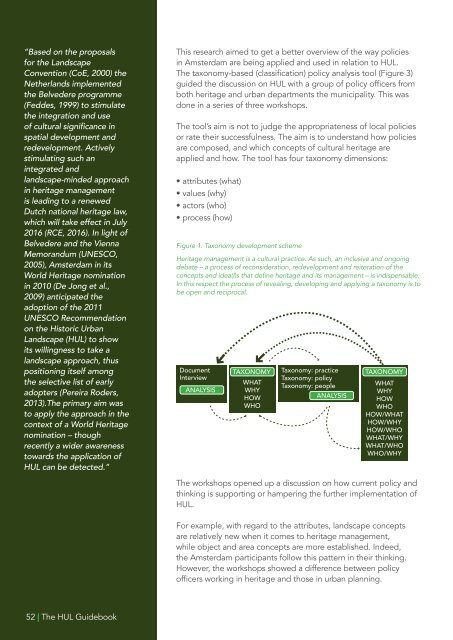GUIDEBOOK
wirey5prpznidqx
wirey5prpznidqx
Create successful ePaper yourself
Turn your PDF publications into a flip-book with our unique Google optimized e-Paper software.
“Based on the proposals<br />
for the Landscape<br />
Convention (CoE, 2000) the<br />
Netherlands implemented<br />
the Belvedere programme<br />
(Feddes, 1999) to stimulate<br />
the integration and use<br />
of cultural significance in<br />
spatial development and<br />
redevelopment. Actively<br />
stimulating such an<br />
integrated and<br />
landscape-minded approach<br />
in heritage management<br />
is leading to a renewed<br />
Dutch national heritage law,<br />
which will take effect in July<br />
2016 (RCE, 2016). In light of<br />
Belvedere and the Vienna<br />
Memorandum (UNESCO,<br />
2005), Amsterdam in its<br />
World Heritage nomination<br />
in 2010 (De Jong et al.,<br />
2009) anticipated the<br />
adoption of the 2011<br />
UNESCO Recommendation<br />
on the Historic Urban<br />
Landscape (HUL) to show<br />
its willingness to take a<br />
landscape approach, thus<br />
positioning itself among<br />
the selective list of early<br />
adopters (Pereira Roders,<br />
2013).The primary aim was<br />
to apply the approach in the<br />
context of a World Heritage<br />
nomination – though<br />
recently a wider awareness<br />
towards the application of<br />
HUL can be detected.”<br />
This research aimed to get a better overview of the way policies<br />
in Amsterdam are being applied and used in relation to HUL.<br />
The taxonomy-based (classification) policy analysis tool (Figure 3)<br />
guided the discussion on HUL with a group of policy officers from<br />
both heritage and urban departments the municipality. This was<br />
done in a series of three workshops.<br />
The tool’s aim is not to judge the appropriateness of local policies<br />
or rate their successfulness. The aim is to understand how policies<br />
are composed, and which concepts of cultural heritage are<br />
applied and how. The tool has four taxonomy dimensions:<br />
• attributes (what)<br />
• values (why)<br />
• actors (who)<br />
• process (how)<br />
Figure 1: Taxonomy development scheme<br />
Heritage management is a cultural practice. As such, an inclusive and ongoing<br />
debate – a process of reconsideration, redevelopment and reiteration of the<br />
concepts and idea(l)s that define heritage and its management – is indispensable.<br />
In this respect the process of revealing, developing and applying a taxonomy is to<br />
be open and reciprocal.<br />
The workshops opened up a discussion on how current policy and<br />
thinking is supporting or hampering the further implementation of<br />
HUL.<br />
For example, with regard to the attributes, landscape concepts<br />
are relatively new when it comes to heritage management,<br />
while object and area concepts are more established. Indeed,<br />
the Amsterdam participants follow this pattern in their thinking.<br />
However, the workshops showed a difference between policy<br />
officers working in heritage and those in urban planning.<br />
52 | The HUL Guidebook


